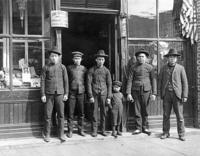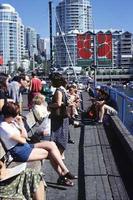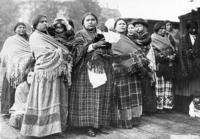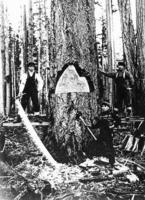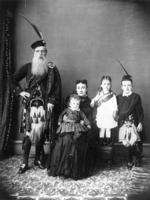Peoples of BC
The population of BC in 2016 was 4,648,055, 13% of the Canadian total, making it the third most populous province in Canada. The population is distributed unevenly geographically. About 70% of residents live in the province's southwest corner: in the LOWER MAINLAND and on southern VANCOUVER ISLAND. Overall population density is 5 people per sq km, but in Vancouver density jumps to 5,492 people.
BC is the only province whose population growth rate has consistently exceeded the national growth rate since CONFEDERATION. Some of the growth is natural (excess of births over deaths); the rest is accounted for by migration from the rest of Canada and immigration from other countries. In the period 1986–96 migration and immigration accounted for 80% of population growth. By 2006, 27.5 of the provincial population was born outside the country. For many years immigration was mainly from Europe and the US, but since the 1960s Asian countries have provided many more immigrants. By 1996, 44% of all immigrants living in BC were from Asian countries; 40% were from Europe. Since WWII, BC's share of total immigration to Canada has been consistently greater than its share of the population. In the mid-1980s, for example, 17% of all immigrants to Canada settled in BC, and the proportion peaked in 1996 at 23%. In 2006 the figure was 16%.
The shift in immigration patterns contributed to a shift in the ethnic makeup of the province's people. Until the 1880s, most people in BC were aboriginal. At Confederation in 1871, for instance, aboriginal people made up 71% of the population. Disease and other factors reduced aboriginal numbers dramatically, however (see ABORIGINAL DEMOGRAPHY), and waves of immigrants to the province swamped the FIRST NATIONS population. Between 1871 and 1911 the white population increased almost 40-fold. Most newcomers came from Britain, either directly or via other parts of Canada, and by 1900 people of British background accounted for 60% of British Columbians. The proportion of BC residents claiming British heritage peaked at 74% in 1921, then slowly declined. Still, most residents were of British background until 1991; the census that year showed the percentage to have slipped below 50% for the first time in 100 years.
This change resulted partly from relaxation of inter-war restrictions on Asian immigration. Between 1961 and 1981 BC's proportion of people of Asian origin tripled to 7.5% of the total population. By 1996 it had almost tripled again to about 20%, reflecting the province's growing orientation toward the PACIFIC RIM. More generally, visible minorities have become a large proportion of the population. In the 1996 census about a third of all Lower Mainland residents identified themselves as members of visible minorities. One of the most striking changes in immigration patterns since 2001 has been the decrease in the number of immigrants from Hong Kong and the increase in the flow from mainland China. In Vancouver alone between 2001 and 2006 there were 35,000 new arrivals from mainland China. More than a quarter of all immigrants to the city during this period originated in mainland China.
As a frontier society, BC initially attracted many more men than women. This imbalance peaked in 1891, when almost 75% of the population was male; it persisted until about WWI, then declined. By 1921 males accounted for 58.5% of residents; approximate parity was reached in the 1950s.
A large post-WWII baby boom generation influences the age structure of the BC population. The province's overall population has aged with this generation because of low birth rates and continually improving life expectancy. In 2001 the median age in BC was 38.4 years; the national average was 37.6. About 13% of the population was over 64 years old. The mild CLIMATE has made BC a favourite destination for retirees, another factor influencing the age structure of the population. Nonetheless, in 2001 BC's concentration of seniors was only the fourth highest of all provinces. Within BC, the Victoria area had the highest concentration of seniors (17.8% of residents).
The population of BC is predicted to reach 6 million by 2026, growing by about 70,000 annually (a growth rate of 1–2%). This is a slowdown from the booming growth rate of the early 1990s, when the population grew by more than 100,000 annually, the fastest growth rate of any province in Canada. By 2026, half the population is expected to be 42 years or older. See also ECONOMY OF BC. See charts.
by Daniel Francis

